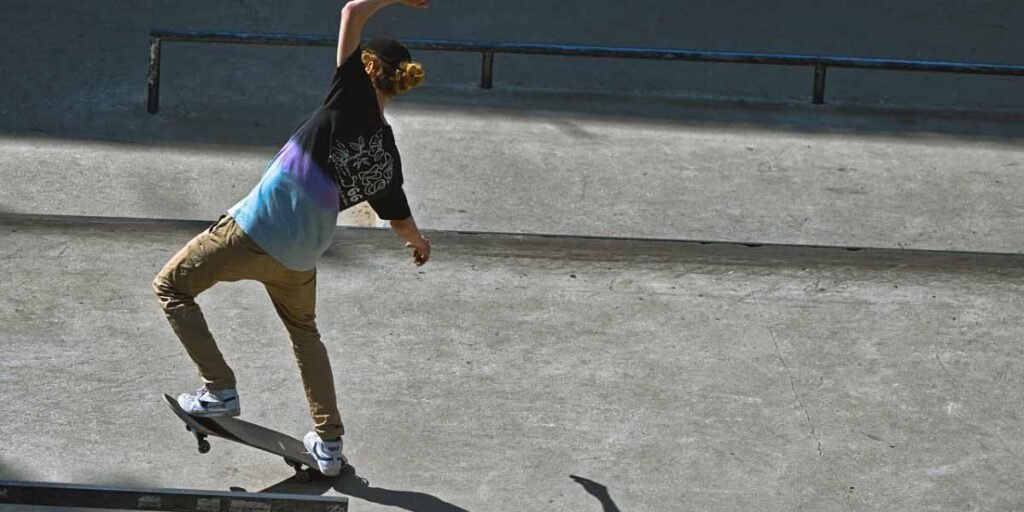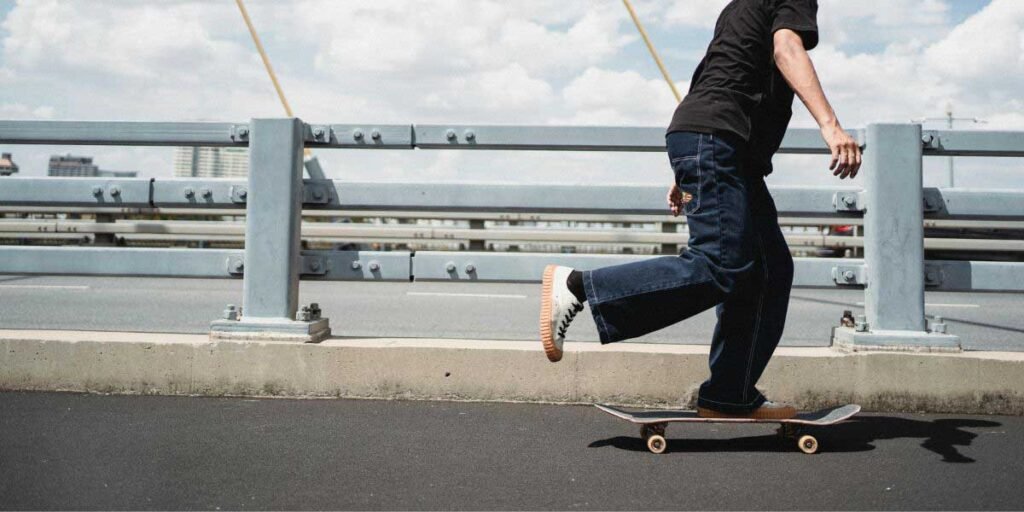Standing on a skateboard for the first time can feel tricky. The board wobbles, your balance feels off, and it’s easy to think you’re doing it wrong. But the truth is, everyone feels like that in the beginning. With the right steps, you’ll learn how to stand on a skateboard with confidence and you’ll be rolling in no time.
This guide will walk you through how to get on a skateboard, find your stance, balance, and start pushing safely.
Stand on a skateboard without fear
You are trying to stand on a skateboard, that’s amazing. Standing on a skateboard isn’t about being perfect but it’s about trusting yourself. Skateboarding without falling is not thrilling. If you’re nervous, practice on grass or carpet so the board stays put. Then, step onto smooth pavement and shift your weight gently from side to side. Every skater started exactly where you are now, and with each practice, your balance, confidence, and control will grow. You’ve got this. Getting on a skateboard can feel effortless, fun, and totally yours.
Step 1: Find Your Stance on a Skateboard
Before you can ride, you need to figure out which stance feels natural. This tells you which foot goes in front and which one does the pushing. The 4 Main Stances in Skateboarding are;
Regular: Left foot forward, right foot pushing or steering.
Goofy: Right foot forward, left foot pushing or steering.
Switch: Riding in the opposite of your natural stance (regular riders switch to goofy, goofy riders switch to regular).
Fakie: Riding backward in your natural stance, with the tail leading instead of the nose.
Start by finding whether you’re regular or goofy, then later you’ll naturally explore switch and fakie as you build skill.
A quick test: Pretend to kick a ball. The foot you kick with usually becomes your back foot, and the other goes in front. There’s no “right” or “wrong” stance—comfort matters more than rules.
Step 2: Start on a Safe Surface
When you’re new, the skateboard feels unstable. The easiest way to practice is on grass, carpet, or even dirt. These surfaces stop the wheels from rolling while you get comfortable.

Always wear a helmet, and if you’re nervous, use knee pads and wrist guards. Safety gear not only protects you, but it also helps you relax while learning.
Step 3: How to Get on a Skateboard
Now let’s learn how to step onto the skateboard or longboard. This is where many beginners feel nervous, but follow these steps and you’ll be fine:
- Place your front foot on the board first. Aim to put it over the front bolts. This is the most stable area.
- Once you feel balanced, bring your back foot onto the board. Place it just above the rear bolts, perpendicular to the board.
- Keep both feet about shoulder-width apart.
That’s it—you’re standing on a skateboard!
Step 4: Perfect Your Stance
Standing the right way on a skateboard makes balancing a lot easier. Keep your knees a little bent so you stay lower and don’t wobble as much. Turn your front foot at a slight angle, about 30 degrees, and place your back foot sideways across the board. Always look forward instead of staring at your feet, because your body follows where your eyes go. Think of yourself like a spring, loose and relaxed, but ready to handle movement.
Step 5: Balance Without Moving
Before you push, practice just standing and balancing. Try this drill:
- Stand on the board in your stance.
- Slowly shift your weight from your front foot to your back foot.
- Rock side to side gently, letting your ankles adjust.
If you wobble, that’s normal. Bend your knees a little more and stay relaxed. The more you practice, the steadier you’ll get.
Step 6: Try Your First Push

Once you can stand still on your skateboard, it’s time to start moving. Place your front foot over the front bolts with a slight forward angle, then use your back foot to push against the ground, almost like you’re scooting. After the push, bring your back foot onto the board and set it across the rear bolts. Keep your knees bent and your eyes looking forward so you stay balanced. At first, you might only roll a few feet and that’s completely fine. Short, slow pushes are the best way to build control and confidence.
How to Get on a Skateboard: Pro Tips for Beginners
Getting on a skateboard for the first time can feel tricky, but a few simple tips can make it easier. Practice stepping on and off the board. Repetition builds confidence and helps you feel more comfortable. Loosen your trucks slightly, as tight trucks can feel stiff, while looser ones turn more easily. Stay low by bending your knees, which gives you better stability and control. And remember, don’t get discouraged if you wobble or fall. Every skater, even the pros, goes through it when learning something new.
Skateboarding Tips for Stability
As a pro skateboarder, I can tell you that staying stable on your board is all about body control and focus. Keep your knees slightly bent and your weight centered over the board. Your feet should be positioned correctly, with your front foot angled forward and your back foot across the rear bolts. Always look ahead, not down at your feet, because your body naturally follows your eyes. Relax your body like a spring; stiffness makes you wobble more. Practice small movements and turns slowly at first, and soon, balancing will feel natural, even at higher speeds.
Skateboarding Tips for Speed
When it comes to speed on a skateboard, control is everything. Keep your knees bent and your body low to stay balanced and absorb bumps. Lean slightly into turns and use your arms for stability. Always look ahead so you can anticipate obstacles or changes in terrain. Push off smoothly and maintain a steady rhythm instead of sudden, hard pushes, which can throw you off balance. Wearing proper safety gear and practicing in open, safe areas will help you build confidence as you learn to handle higher speeds.
Final Thoughts
So, how do you stand on a skateboard? Start by finding your stance, step on the bolts one foot at a time, bend your knees, and look forward. Practice balancing on safe ground before rolling, and soon you’ll feel at home on your board.
Remember, every skater started where you are now. Once you master standing, pushing, and turning will come naturally. Grab your board, take it step by step, and enjoy the ride.
FAQs
What is the correct feet placement on a skateboard?
Your front foot should be angled slightly forward over the front bolts, and your back foot should be placed across the rear bolts. This gives you balance and control while riding.
Which foot goes forward on a skateboard?
Your front foot is the one you place at the front of the board, angled slightly forward. The other foot, your back foot, is used to push and then rests across the rear bolts.
Which foot should I push with on a skateboard?
Most skaters push with their back foot while keeping their front foot on the board. After pushing, place your back foot back on the board to continue riding.
What is the proper way to stand on a skateboard?
Place your front foot near the front bolts and your back foot near the tail. Keep your knees slightly bent, shoulders relaxed, and body centered over the board for balance.
How do you get used to standing on a skateboard?
Start by practicing on grass or carpet so the board doesn’t roll. Work on balancing with your knees bent and shifting your weight side to side before moving to smooth pavement.
How should you stand on a skateboard if you’re right-handed?
Handedness doesn’t decide your stance. Most right-handed people ride regular (left foot forward), but some prefer goofy (right foot forward). Try both and see which feels more natural.
How do beginners balance on a skateboard?
Keep your knees bent, feet shoulder-width apart, and your weight centered. Look ahead instead of at your feet, and use your arms for balance.
Are you supposed to push with your front or back foot on a skateboard?
Beginners should push with their back foot while keeping their front foot steady on the board. Pushing with the front foot (called “mongo”) is less common and harder to balance.
How do I stand on a skateboard for the first time?
Place your front foot over the front bolts for stability, then gently bring your back foot on—ideally over the back bolts. Try the T-stance (feet forming a “T”) as a transitional position to build balance before committing to the riding stance
What is the T-stance and should I use it?
The T-stance is when your front foot is over the front bolts and your back foot is sideways across the rear bolts, forming a “T” shape. It’s a brief, balance-focused setup that helps ease beginners into standing on the board before moving.

